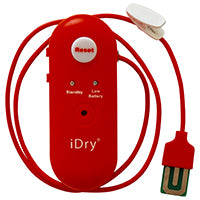Bedwetting Causes and Treatment
May 09, 2019

Bedwetting also called enuresis has four main causes. Many people treat only one cause, deep sleep. They expect that by using a bedwetting alarm their child will wake to the alarm and stop wetting the bed. This can lead to disappointment as even when an initial cure is achieved relapses are common.
By treating all four causes of bed wetting it is more likely that a permanent cure will be achieved. Many parents deny their child has these other contributing factors, however, research has shown that these factors affect many children who wet the bed.
Unless all factors are resolved it can be difficult to achieve a permanent cure.
The main causes are
- small bladder capacity;
- too much urine at night;
- constipation or a slow bowel; and
- very deep sleep.
The Bedwetting Cured DVD with Physiotherapist, Margaret O’Donovan, and Dr Mark Condon outlines a successful treatment program to follow at home.
Margaret has been successfully treating bedwetting and continence concerns at her Canberra practice for fifteen years.
The Bed Wetting Institute recommends starting with the first three steps on the DVD and following these steps for three weeks.
For a few children this will be all that is required to achieve a cure. Other children improve by starting to have occasional dry nights or a reduced volume of urine at night or wetting a bit later at night.
The initial steps on the DVD, including a drinking program, will help to prepare your child to respond to the alarm. Each strategy may help your child improve another 10% to 20% towards a cure so each step plays an important part.
The drinking program on the DVD helps to get the bladder brain connection working properly. It also makes your child produce more urine in the daytime rather than at night and helps to expand the child’s bladder capacity.
Constipation also needs to be addressed as a full bowel can squash the bladder and stop it expanding fully. By starting all the steps on the DVD your child may start having occasional dry nights.
Most children will then need to start a bedwetting alarm so that they can get a complete cure. Major improvement is sometimes enough for a parent but it is never enough for a child. The child needs complete resolution of the problem to feel completely confident to participate in activities like school camps and sleepovers away from home.
By starting with the steps on the DVD the alarm may only go off once a night instead of two or three times each night. This means parents are more likely to continue the program until the child achieves a permanent cure. The child will also be less tired in the morning.
The Bedwetting Cured DVD also demonstrates how to get the best results with a bed wetting alarm. Many parents are told to purchase a bedwetting alarm without being given any direction on how to use it to get the best results. This can lead to a broken alarm and frustrated parents.
Bedwetting Alarms – three types
Body Worn alarms
Pin-on and Clip-on alarms attach at the shoulder and have a lead which runs down between a singlet and T-shirt to the underpants. The moisture sensor attaches to the underpants.
Wireless Alarms
Wireless alarms have the sound box on the bedside table but a transmitter with sensor attaches to the underpants. This is larger than the sensors on the clip-on alarms. We have found that the wireless alarms are not as reliable as the corded alarms. There may be interference from other wireless products in the house. Also, the electronics are in close proximity to the urine.
Pad and Bell alarms
Our Pad and Bell alarms are extremely loud. The sound box goes on the bedside table. The alarm mat goes on top of the fitted sheet. Pad and Bell Alarms are much louder than many body worn alarms. They are recommended for very deep sleepers. Nothing attaches to the child. A wire goes from the alarm mat on the bed to the alarm box on the bedside table. They can be used for children of any age but are the first choice for children aged 9 or older. They are also recommended for children who have previously tried a body worn alarm without success. For children only wetting occasionally the alarm mat can be put under the fitted sheet. The child cannot wear pull-ups with this type of alarm.
Combination Clip-on and Pad and Bell alarms
Our iDry alarm can be used as either a clip-on or pad and bell alarm. Use whichever method suits you initially. Once the bedwetting has resolved place the alarm mat under the fitted sheet and continue to connect the alarm at night. This way the alarm can be left in place for another couple of months just to be sure the child has achieved a complete cure.
Pull-ups
Many doctors and nurses recommend removing pull-ups. All this does is make more work for the parent without actually curing the problem. It is worth trying your child without pull-ups for two weeks every six months to check the pull-ups are not part of the problem. Use a waterproof mattress overlay instead. We have found pull-ups can be used while you follow the steps on the DVD. If you want to continue with the pull-ups while using an alarm you can do this with the body worn alarms. Use one pair of underpants and put pull-ups over the top. The sensor goes in-between the underpants and pull-ups. The pull-ups allow the sensor to get wet and so the alarm sounds but the sheets stay dry making your workload less, which will help you continue with the program. You cannot use pull-ups with the Pad and Bell alarms. Once your child has improved and is wetting about once a week take the pull-ups off and start using one of the waterproof mattress pad overlays.
Medication
Medication should not be a first option. Try the steps on the Bedwetting Cured DVD and a bedwetting alarm for at least three months first.
There are two ways to try medication.
- Trial to cure the problem
If the whole family needs a break then try medication for three to six months along with the steps on the Bedwetting Cured DVD. Then wean off the medication and see if the bedwetting is cured. It rarely works as a complete cure as the bedwetting often returns when the medication is stopped but it may be needed to give everyone a well deserved break.
- Cover for short term events
Try the medication for a few weeks to see if it works. If it completely stops the bedwetting it can then be used in case of school camps and holidays. If only a partial improvement occurs then you know it cannot be relied on when needed.
We recommend getting one of the Bedwetting Alarm and DVD Kits.
For more details on bedwetting alarms see Choosing a Bedwetting Enuresis Alarm
https://www.bedwettinginstitute.com.au/collections/bedwetting-alarms-1





